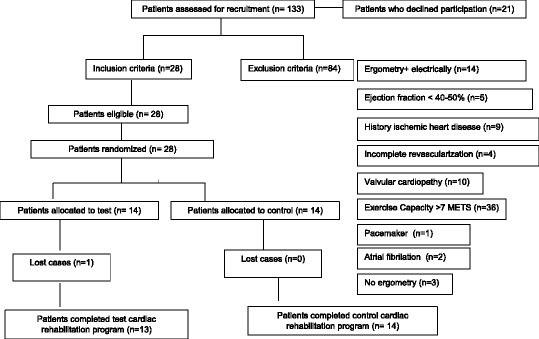Effectiveness and safety of a home-based cardiac rehabilitation programme of mixed surveillance in patients with ischemic heart disease at moderate cardiovascular risk: A randomised, controlled clinical trial
- PMID: 28219338
- PMCID: PMC5319164
- DOI: 10.1186/s12872-017-0499-0
Effectiveness and safety of a home-based cardiac rehabilitation programme of mixed surveillance in patients with ischemic heart disease at moderate cardiovascular risk: A randomised, controlled clinical trial
Abstract
Background: Previous studies have documented the feasibility of home-based cardiac rehabilitation programmes in low-risk patients with ischemic heart disease, but a similar solution needs to be found for patients at moderate cardiovascular risk. The objective of this study was to analyse the effectiveness and safety of a home-based cardiac rehabilitation programme of mixed surveillance in patients with ischemic cardiopathology at moderate cardiovascular risk.
Methods: A randomised, controlled clinical trial was designed wherein 28 patients with stable coronary artery disease at moderate cardiovascular risk, who met the selection criteria for this study, participated. Of these, 14 were assigned to the group undergoing traditional cardiac rehabilitation in hospital (control group) and 14 were assigned to the home-based mixed surveillance programme (experimental group). The patients in the experimental group went to the cardiac rehabilitation unit once a week and exercised at home, which was monitored with a remote electrocardiographic monitoring device (NUUBO®). The in-home exercises comprised of walking at 70% of heart rate reserve during the first month, and 80% during the second month, for 1 h per day at a frequency of 5 to 7 days per week. A two-way repeated measures analysis of variance (ANOVA) was performed to evaluate the effects of time (before and after intervention) and time-group interaction regarding exercise capacity, risk profile, cardiovascular complications, and quality of life.
Results: No significant differences were observed between the traditional cardiac rehabilitation group and the home-based with mixed surveillance group for exercise time and METS achieved during the exertion test, and the recovery rate in the first minute (which increased in both groups after the intervention). The only difference between the two groups was for quality of life scores (10.93 [IC95%: 17.251, 3.334, p = 0.007] vs -4.314 [IC95%: -11.414, 2.787; p = 0.206]). No serious heart-related complications were recorded during the cardiac rehabilitation programme.
Conclusions: The home-based cardiac rehabilitation programme with mixed surveillance appears to be as effective and safe as the traditional model in patients with ischemic heart disease who are at moderate cardiovascular risk. However, the cardiac rehabilitation programmes carried out in hospital seems to have better results in improving the quality of life.
Trial registration: Retrospectively registered NCT02796404 (May 23, 2016).
Keywords: Exercise therapy; Myocardial ischemia; Rehabilitation; Telemedicine.
References
-
- Grazzi G, Mazzoni G, Myers J, Codecà L, Pasanisi G, Napoli N, Guerzoni F, Volpato S, Conconi F, Chiaranda G. Improved walking speed is associated with lower hospitalization rates in patients in an exercise-based secondary prevention program. Heart. 2016. doi:10.1136/heartjnl-2015-309126. - PubMed
-
- Grazzi G, Myers J, Bernardi E, Terranova F, Grossi G, Codecà L, Volpato S, Conconi F, Mazzoni G, Chiaranda G. Association between VO2 peak estimated by a 1-km treadmill walk and mortality. A 10-year follow-up study in patients with cardiovascular disease. Int J Cardiol. 2014;173(2):248–252. doi: 10.1016/j.ijcard.2014.02.039. - DOI - PubMed
Publication types
MeSH terms
Associated data
LinkOut - more resources
Full Text Sources
Other Literature Sources
Medical
Miscellaneous


